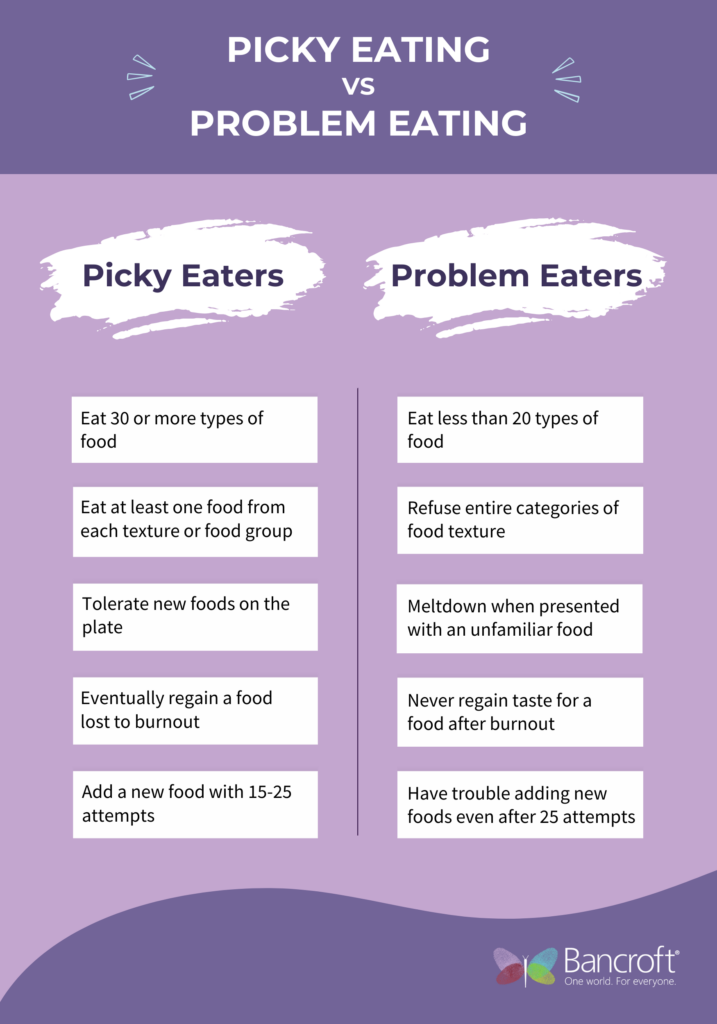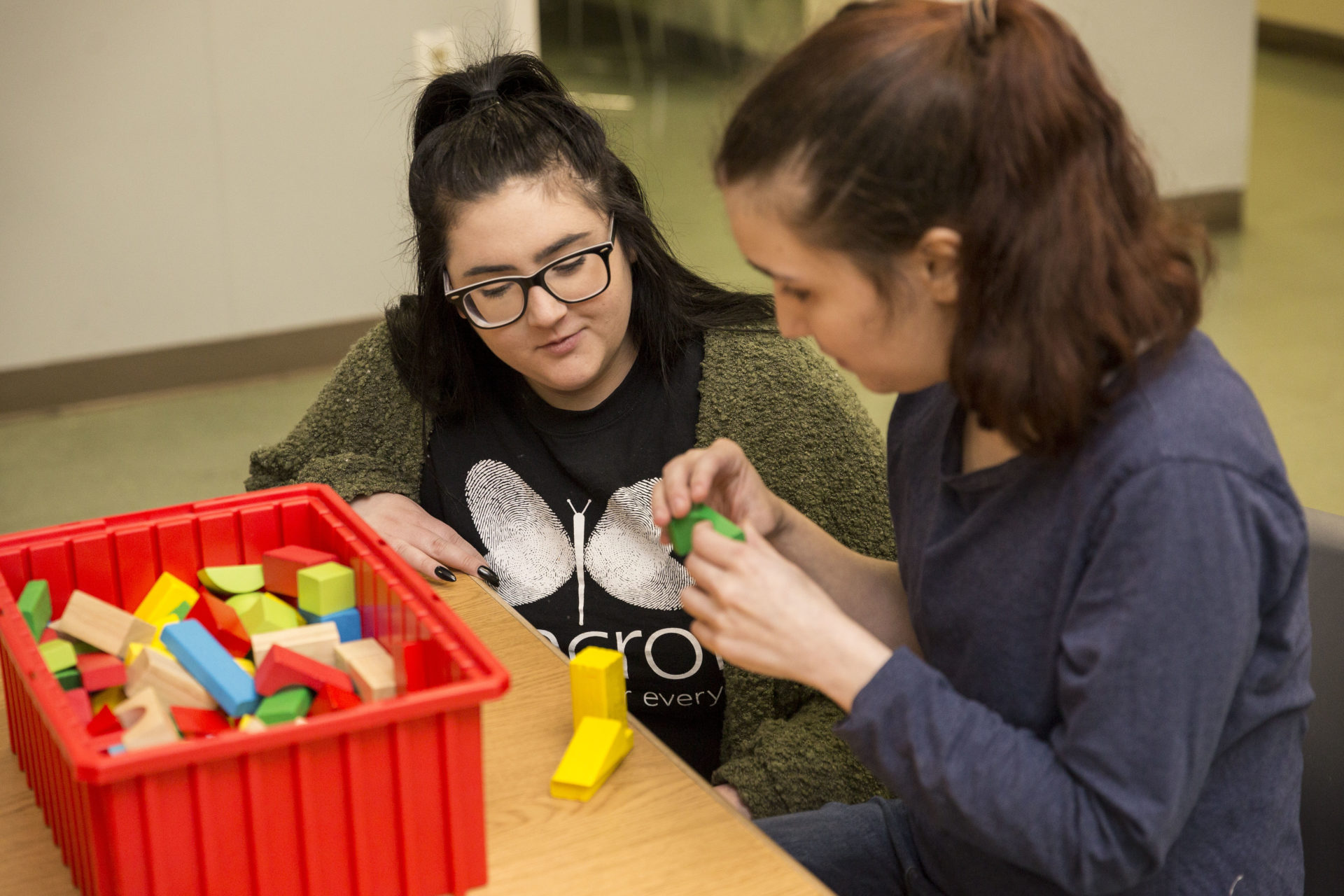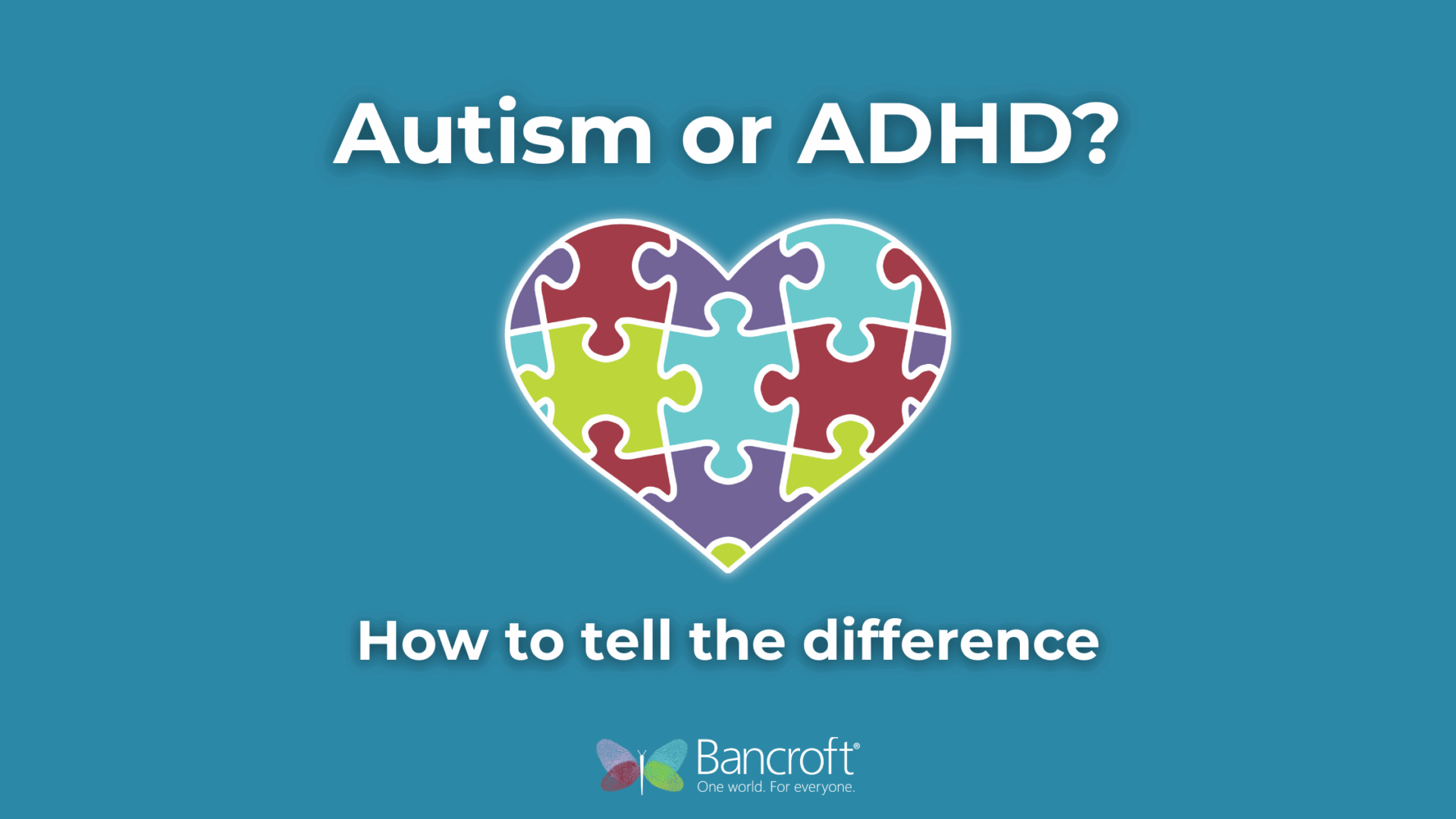By Robert Trombley, RDN, Registered Dietitian Nutritionist at Bancroft
It’s nearing bedtime and your child has yet to eat a bite of dinner. You’re desperate and begin pleading with them to ingest a single morsel of chicken, veggies or pasta. You’re willing to throw in the towel and allow them a bowl of sugary cereal or a couple handfuls of Goldfish crackers just so you can turn the kitchen lights out and move on to the bedtime routine. When they refuse even these old standby favorites, you give up and let them fall asleep hungry – just like two other nights this week.
Picky eating is a common occurrence in children, and picky eating and autism often go hand-in-hand. But sometimes children with autism encounter challenges that can turn picky eating into problem eating. Sensory processing issues may increase sensitivities to taste, texture, and smell, contributing to food aversion. So, how do you distinguish between picky eating and a potential problem? And how do you determine whether an adverse reaction to food is a sensory-related issue, a food intolerance or a food allergy?
As a Registered Dietitian and Nutritionist at Bancroft, where we serve children and adults with autism and other intellectual and developmental disabilities, I understand the complexities of autism and picky eating. The good news is that both picky and problem eating can be overcome with time, trial and error, and appropriate accommodations.
Ruling Out a Food Allergy

Before diving into strategies to address picky and problem eating in children with autism, it’s important to rule out any food allergies. Allergic reactions typically develop within a few minutes to two hours after eating the offending food. Some common symptoms are:
- Tingling or itching in the mouth or on the lips
- Hives, itching or eczema on the face or body
- Swelling of the lips, face, tongue, and throat
- Belly pain, diarrhea, nausea or vomiting
- Dizziness, lightheadedness or fainting
A food allergy can sometimes trigger a severe allergic reaction called anaphylaxis. If your child experiences any of the following symptoms, seek immediate emergency treatment:
- Constriction and/or tightening of the airway
- A swollen throat or sensation of a lump in the throat making it hard to breathe
- Shock with severe drop in blood pressure
- Rapid pulse, lightheadedness, dizziness or loss of consciousness
Allergy testing, including skin prick tests or blood tests, can help pinpoint the specific allergens causing negative reactions. These tests are valuable tools in ruling out or confirming suspected food allergies.
Food Allergy or Food Intolerance?
Sometimes an adverse reaction to food is a sign of an intolerance or sensitivity, rather than a food allergy. For example, some individuals are gluten intolerant or lactose intolerant. A gastroenterologist can conduct tests such as an endoscopy or breath test to diagnose conditions like celiac disease or lactose intolerance.
Even if your child doesn’t have celiac disease or a true intolerance to lactose, they can still have a sensitivity to gluten or dairy and experience symptoms such as bloating, cramping or fatigue. Other common food intolerances or sensitivities include salicylates, amines, FODMAPs, sulfites, eggs, MSG, food coloring, soy or sugar alcohols.
If you suspect your child has food sensitivities, working with a registered dietitian on an elimination diet can help identify trigger foods. I do not recommend attempting an elimination diet on your own, as a dietitian has the expertise to interpret the results and will help ensure there are no nutritional deficiencies throughout the process.
Picky Eating vs. Problem Eating
Once you have ruled out any food sensitivities or allergies, use the following lists to determine whether your child is experiencing picky or problem eating:
Picky eaters will:
- Eat 30 or more types of food
- Eat at least one food from each texture or food group
- Tolerate new foods on the plate
- Eventually regain a food lost to burnout
- Add a new food with 15-25 attempts
Problem eaters will:
- Eat fewer than 20 types of food
- Refuse entire categories of food texture (all soft foods or all crunchy foods, for example)
- Meltdown when presented with an unfamiliar food
- Never regain taste for a food after burnout (or, once he’s sick of apple slices, he’s never touching them again).
- Have trouble adding new foods even after 25 attempts

The Role of Sensory Processing in Food Selectivity
Children with autism often experience sensory processing issues that significantly impact their relationship with food. These sensory issues can manifest as heightened sensitivities to taste, texture, and smell, presenting distinct obstacles during mealtime.
Taste Sensitivities:
Children with autism may exhibit extreme sensitivities to tastes, finding certain flavors overpowering or aversive. Bitterness, sweetness, or other taste factors can trigger strong reactions, leading to intense food aversions. Recognizing these taste sensitivities allows parents to introduce new foods gradually, starting with flavors that align with your child’s preferences.
Texture Sensitivities:
Texture aversions are common among children with autism. Some may avoid foods with certain consistencies, such as the crunchiness of raw vegetables or the sliminess of certain fruits. Parents can address texture sensitivities by experimenting with cooking methods, transforming textures to make them more palatable.
Smell Sensitivities:
Strong odors from certain foods may be overwhelming for children with autism. Parents can explore ways to mask or modify odors during meal preparation, making the introduction of new foods less intimidating. Additionally, they can try involving the child in the cooking process. This may help desensitize them to different smells over time.
Visual Sensitivities:
Sensory processing issues aren’t limited to taste, texture, and smell – visual sensitivities can also play a role. The appearance of certain foods may trigger aversions. Parents can try presenting foods in a more visually appealing manner or exploring creative ways to incorporate familiar visual elements into new dishes.
Solutions for Both Picky and Problem Eaters
While food aversion is common in children with autism, there is no one-size-fits-all solution. Dealing with picky eating habits, whether it’s just regular fussiness or a more serious problem, is a process of trial and error that requires patience and consistency above all. Here are some tips and solutions I offer parents at Bancroft:

1. Identify Commonalities
Identify the commonalities between the foods your child prefers. Do they have similar color, tastes, textures or smells? These common preferences will provide the foundation for how you introduce new foods to your child. For example, if your child prefers soft foods, you can try baking fruits and vegetables they normally don’t like to create that same consistency.
2. Take Baby Steps
Gradual exposure is key to success. Start with tiny, non-threatening portions – pea-sized bites of the trial food. Focus on small wins. If your child takes a microscopic bite the first time you introduce a new food, don’t be discouraged. All progress is a step in the right direction. Consistency and patience are the name of the game.
3. Consider a Food Waste Plate
When introducing new foods, providing a food waste plate can help your child feel more in control during mealtime. This designated plate allows them to set aside any unwanted food, which can make them more comfortable and willing to engage with new foods on their own terms.

4. Engage the Senses
Leverage the senses to make eating a more engaging experience. Let your child play with their food, encouraging hands-on exploration through touch, smell and sight. This kind of sensory play helps them become acquainted with different foods in a safe and non-threatening way.
5. Create Consistent Mealtime Routines
Children with autism flourish in structured and predictable environments. Set you and your child up for success with consistent mealtime schedules and routines. This creates a more relaxed and enjoyable dining experience, reducing the anxiety associated with trying new foods.
6. Get Them Involved
Involving your child in the food preparation process offers valuable sensory exposure and instills a sense of control over their meals. Allowing them to take part in tasks like washing, cutting or stirring fosters feelings of accomplishment and pride. This approach can help nurture positive associations with foods they might otherwise avoid.
7. Give Positive Reinforcement
It’s important to celebrate small victories and acknowledge the efforts your child makes in trying new foods. Offering positive reinforcement through praise can help emphasize these achievements. Every bit of progress, no matter how small, is a step in the right direction.

8. Be Patient and Consistent
As I emphasized earlier, this process requires patience and consistency above all. Changes in eating behaviors can take time. Don’t lose heart if your efforts don’t yield immediate results. Be patient with yourself, your child and the process. What doesn’t work today could lead to positive outcomes in the future. With a consistent and steady approach, you create an environment that nurtures positive eating experiences and fosters forward progress.
As you navigate this journey with your child, it can be helpful to view it as an exploration rather than a challenge or obstacle to overcome. This lens alleviates pressure and feelings of failure and frustration. It’s not about wins and losses, but rather about discoveries and findings. Everything that happens along the way (good or bad) teaches you something and takes you one step closer to your goal of a healthier, more diverse diet for your child.
Finally, don’t try to go it alone. Seek the help of your child’s teachers, therapists, dietician, and other trained professionals. They will help make the road to success a lot less bumpy!
Bancroft offers a range of programs and resources that are designed to help children with autism unlock their potential and prepare for a bright future. We invite you to visit our Children’s Services page to learn more about how we can support your child on their journey to success.















